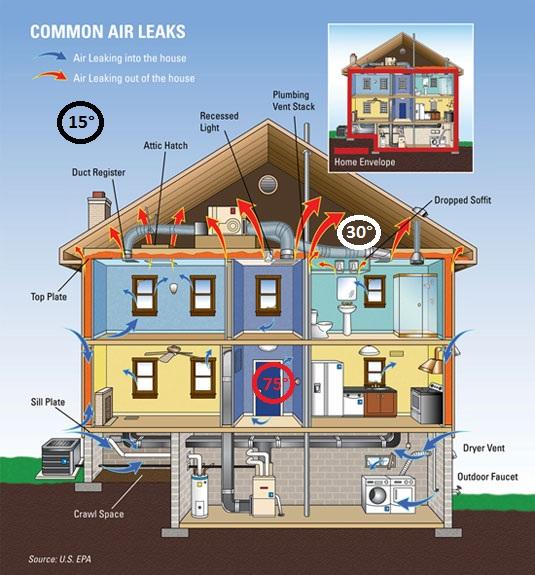
Want to stay snuggly warm in your home this winter without having to constantly blast your heater?
Try this experiment. Open your pull-down stairs or scuttle hole to the attic on a cold day when your home is warm. Climb up into the attic and then put your face over the hole. You'll feel what’s called the Stack Effect pushing lots of warm air into the attic. The same convection force that makes a hot-air balloon rise can cause a house to have major comfort and energy problems.
What is the Stack Effect? Warm air rises when it's surrounded by cold air because of its lower density. Yes, that's due to heat, but density is the main factor causing the movement. This phenomenon is Stack Effect. Two factors affect how much the Stack Effect your home is experiencing:
- Temperature difference between inside and out (because density depends on temperature)
- Height of the home
With the cold weather, the Stack Effect is the strongest, so your heated air is constantly escaping and it’s being replaced by an equal volume of cold outside air. This cycle continues 24/7, so if you don’t fix the problem, you’re going to be spending a lot of money to keep warm.

According to Dept. of Energy research, attic air sealing, when combined with an attic insulation upgrade, can cut your heating and cooling costs nearly in half!
In winter this low density air inside your house wants to rise...if it can. If your house has no leaks, the warm air can't escape which means you’re money isn’t escaping either! There's still a pressure difference across the building envelope, but that's no problem if the air barrier's good. This positive pressure inside the house has nowhere to go because at Orange Energy Solutions we fix this problem and remove the pathways.
Here’s the reality - homes leak. Your nice warm air finds way to leak out (exfiltration) and cold air leaks in (infiltration). Because of its lower density, the warm air will leak out the top of the house if there are leaks there. When a cubic foot leaks out, however, it has to be made up by a cubic foot leaking in. As the warm air leaks out at the top, cold air leaks in at the bottom. The leakier your house is, the more temperature difference you'll notice between the top and bottom of the house.
Not only do you feel cold drafts throughout your home, but your heating and cooling systems have to work harder to maintain comfortable temperatures.
Is the Stack Effect At Work in Your Home? Our energy audit will determine your home's performance and get your home ready to be air sealed an insulated.
